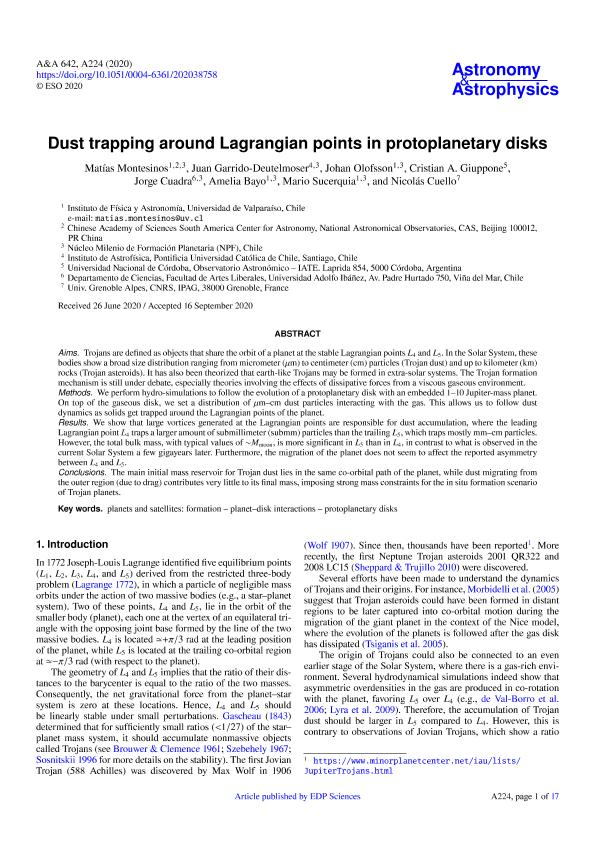Mostrar el registro sencillo del ítem
dc.contributor.author
Montesinos, Matías
dc.contributor.author
Garrido-Deutelmoser, Juan
dc.contributor.author
Olofsson, Johan
dc.contributor.author
Giuppone, Cristian Andrés

dc.contributor.author
Cuadra, Jorge
dc.contributor.author
Bayo, Amelia
dc.contributor.author
Sucerquia, Mario
dc.contributor.author
Cuello, Nicolás
dc.date.available
2021-04-16T20:26:17Z
dc.date.issued
2020-10
dc.identifier.citation
Montesinos, Matías; Garrido-Deutelmoser, Juan; Olofsson, Johan; Giuppone, Cristian Andrés; Cuadra, Jorge; et al.; Dust trapping around Lagrangian points in protoplanetary disks; EDP Sciences; Astronomy and Astrophysics; 642; 10-2020; 1-17
dc.identifier.issn
0004-6361
dc.identifier.uri
http://hdl.handle.net/11336/130243
dc.description.abstract
Trojans are defined as objects that share the orbit of a planet at the stable Lagrangian points L4 and L5. In the Solar System, these bodies show a broad size distribution ranging from micrometer (μm) to centimeter (cm) particles (Trojan dust) and up to kilometer (km) rocks (Trojan asteroids). It has also been theorized that earth-like Trojans may be formed in extra-solar systems. The Trojan formation mechanism is still under debate, especially theories involving the effects of dissipative forces from a viscous gaseous environment. Methods. We perform hydro-simulations to follow the evolution of a protoplanetary disk with an embedded 1-10 Jupiter-mass planet. On top of the gaseous disk, we set a distribution of μm-cm dust particles interacting with the gas. This allows us to follow dust dynamics as solids get trapped around the Lagrangian points of the planet. Results. We show that large vortices generated at the Lagrangian points are responsible for dust accumulation, where the leading Lagrangian point L4 traps a larger amount of submillimeter (submm) particles than the trailing L5, which traps mostly mm-cm particles. However, the total bulk mass, with typical values of ~Mmoon, is more significant in L5 than in L4, in contrast to what is observed in the current Solar System a few gigayears later. Furthermore, the migration of the planet does not seem to affect the reported asymmetry between L4 and L5. Conclusions. The main initial mass reservoir for Trojan dust lies in the same co-orbital path of the planet, while dust migrating from the outer region (due to drag) contributes very little to its final mass, imposing strong mass constraints for the in situ formation scenario of Trojan planets.
dc.format
application/pdf
dc.language.iso
eng
dc.publisher
EDP Sciences

dc.rights
info:eu-repo/semantics/openAccess
dc.rights.uri
https://creativecommons.org/licenses/by-nc-sa/2.5/ar/
dc.subject
PLANET-DISK INTERACTIONS
dc.subject
PLANETS AND SATELLITES: FORMATION
dc.subject
PROTOPLANETARY DISKS
dc.subject.classification
Astronomía

dc.subject.classification
Ciencias Físicas

dc.subject.classification
CIENCIAS NATURALES Y EXACTAS

dc.title
Dust trapping around Lagrangian points in protoplanetary disks
dc.type
info:eu-repo/semantics/article
dc.type
info:ar-repo/semantics/artículo
dc.type
info:eu-repo/semantics/publishedVersion
dc.date.updated
2021-03-26T19:35:05Z
dc.identifier.eissn
1432-0746
dc.journal.volume
642
dc.journal.pagination
1-17
dc.journal.pais
Francia

dc.journal.ciudad
Paris
dc.description.fil
Fil: Montesinos, Matías. Universidad de Valparaíso; Chile
dc.description.fil
Fil: Garrido-Deutelmoser, Juan. Pontificia Universidad Católica de Chile; Chile
dc.description.fil
Fil: Olofsson, Johan. Universidad de Valparaíso; Chile
dc.description.fil
Fil: Giuppone, Cristian Andrés. Consejo Nacional de Investigaciones Científicas y Técnicas. Centro Científico Tecnológico Conicet - Córdoba. Instituto de Astronomía Teórica y Experimental. Universidad Nacional de Córdoba. Observatorio Astronómico de Córdoba. Instituto de Astronomía Teórica y Experimental; Argentina. Universidad Nacional de Córdoba. Observatorio Astronómico de Córdoba; Argentina
dc.description.fil
Fil: Cuadra, Jorge. Pontificia Universidad Católica de Chile; Chile
dc.description.fil
Fil: Bayo, Amelia. Universidad de Valparaíso; Chile
dc.description.fil
Fil: Sucerquia, Mario. Universidad de Valparaíso; Chile
dc.description.fil
Fil: Cuello, Nicolás. Universite Grenoble Alpes.; Francia
dc.journal.title
Astronomy and Astrophysics

dc.relation.alternativeid
info:eu-repo/semantics/altIdentifier/url/https://www.aanda.org/10.1051/0004-6361/202038758
dc.relation.alternativeid
info:eu-repo/semantics/altIdentifier/doi/http://dx.doi.org/10.1051/0004-6361/202038758
Archivos asociados
